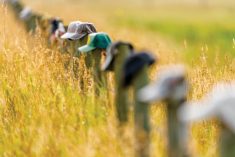December is an excellent time to review your finances and to make sure you are setting up your farm business for the biggest profits possible in 2023. That means taking certain actions and avoiding others.
For some farm business strategies, we checked in with Hollie Rudy, a territory manager with Nutrien Financial who also farms with her family in Iowa. Nutrien Financial, which is affiliated with Nutrien Ag Solutions, entered the Canadian market in 2022, offering various financial services for farmers. Here’s what Rudy had to say.
Don’t wait
Read Also

Managing through market or individual stock declines
Even the best of public-traded companies can periodically experience significant drawdowns, and a successful investor should be prepared to react — or not react — accordingly, Herman VanGenderen writes.
Rudy says it’s best to look at your financial position now so if you decide to participate in various incentive programs, you can do so while they are still available. “A lot of times we farmers wait and then we miss out on incentives for seed or limited time offer financing programs.”
Some farmers may be hesitant to lock into programs and capitalize on early incentive opportunities because they don’t feel prepared to make these decisions before the programs or opportunities have expired. To feel more ready, Rudy advises consulting with your accountant and other financial partners as soon as possible to get that sky-high view of your operation.
This can be done by looking at your tax position, analyzing depreciating assets and examining whether you need to make business investments such as large equipment purchases. You can also look at how grain contracts factor in and how they affect cash flow on your farm. It’s also a good idea to review contributions to your retirement savings plan.
“If we lock in our production costs, seed and fertilizer, we may of course avoid shortages but it’s very important from a financial perspective in two ways,” says Rudy. “We gain savings (through incentive programs) but it also helps us to look forward.
“If we know our costs of production now for 2023, we have a better idea of what our capital management strategies need to be, how better to plan the timing of grain marketing (and) how to factor in what investments we need to make,” she adds. “Anytime you can take advantage of early programs and secure those lower input prices early, you should do it.”
Consider all options
Shop around and make notes of what’s available from all of the seed companies and financial companies, says Rudy. It can be a big mistake to simply do what you did last year or make decisions without knowing all of your options.
Be clear on cash
Rudy notes while it certainly can be wise to take advantage of great deals for seed that require payment in cash, if you are getting cash from an operating loan, you need to factor the cost of borrowing this cash into the input price.
“If you are using cash from an operating loan, that is likely a variable-rate loan, so you need to look at how fast you will be able to pay that back and how much the rate could increase before it’s paid off,” she says. “You’ll only know the true cost of borrowing that cash after it’s paid for, so you need to work with your financial team members to understand cash flow and get it paid at speed.”
Understand your borrowing rate
Farmers should look at all of their financing options and aim for a good overall blended rate, says Rudy.
“There tends to be a misconception out there about what a truly blended rate means,” she explains. “I just worked with a grower where we did a commitment to buy seed, with payment due next fall using fixed-rate borrowing. If you’re combining rate financing with some low- or no-cost programs, then you need to realize that the fixed rate of interest you are paying for all of your inputs is actually much lower when you look at your big picture.”
Rudy also reminds growers it’s always worth inquiring about extended payment terms, if needed. Some payback leniency is always a good idea, she says, and nowadays due to more financing competition, options to pay early or pay later are being offered more readily.
Have a good team around you
Good farm business managers already know a farm business team of experts is a must. “Relationships are important,” says Rudy. “You need tax people, input dealers, equipment dealers, lenders. Incorporate the experts you need into your operation.
“Don’t fix what’s not broken but you should always be looking at how you as a team can make your situation better,” she advises. “You’re always doing that with crop management, so do the same with grain contracts, borrowing and other aspects of the business.”
Rudy urges farmers to look for ways to make the business side more efficient, so their efforts in crop production are not wasted. “Financial efficiency is one of the things that we can do better as farmers. The long-term financial stability of a farm business is all about maximizing profitability. And if you are financially stable, then you are also ready if you want to grow or if life throws a curveball.”















